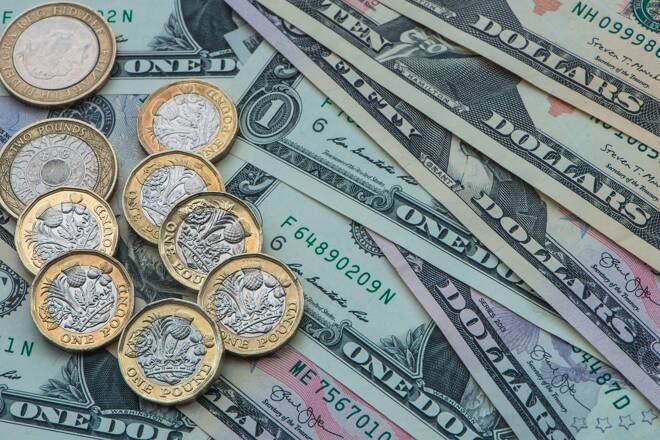Advertisement
Advertisement
GBP to USD Forecast: Cable Tensions Rise with UK GDP and US CPI Spotlight
By:
Cable movements reflect broader economic tremors as UK's GDP report meets US's CPI data.
In this article:
Highlights
- On Tuesday, GBP/USD fell by 0.17%, reversing from Monday’s 0.36% uptick, closing at $1.24879.
- Market anticipation: BoE holds rates, but US CPI may drive renewed Fed rate hike discussions.
- The US CPI Report’s influence on GBP/USD will hinge on the anticipated easing of core inflation.
Overview of the Tuesday Session
On Tuesday, the GBP to USD pair declined by 0.17%. Following a 0.36% gain from Monday, the GBP/USD ended the day at $1.24879. The GBP/USD pair rose to a session high of $1.25295 before falling to a low of $1.24592.
UK GDP Report in the Spotlight
The UK GDP Report will garner interest. Recent economic indicators raised the prospects of a UK economic recession. The services sector contracted in August, with retail sales tumbling 1.2% in July.
UK labor market conditions also deteriorated in July, with a rise in the UK unemployment rate suggesting a likely softening in wage growth. Softer wage growth would lead to a pullback in spending, weaker service sector activity, and softer demand-driven inflationary pressures.
The UK services sector accounts for about 80% of the UK GDP and employment.
The trend in economic indicators suggests the UK macroeconomic environment could weaken further. Economists forecast the UK economy to contract by 0.2% in July. Economists expect a 1.0% slide in manufacturing production to impact the UK economy.
US CPI Report in the Spotlight
The US CPI Report will provide the GBP/USD pair with direction early in the US session. Investors are banking on softer core inflation to allow the Fed to end its monetary policy tightening cycle.
However, hotter-than-expected core inflation could refuel bets on a final Fed interest rate hike. Economists forecast the US core inflation rate to soften from 4.7% to 4.3% in August. In contrast, economists expect the US inflation rate to accelerate from 3.2% to 3.6%. With core inflation as the focal point, we expect increased sensitivity to the numbers.
Elevated inflation would force the Fed to raise interest rates higher to curb spending and ease demand-driven inflation.
Short-Term Forecast
The near-term GBP/USD trend depends on the UK GDP and US CPI Reports. With the markets expecting the BoE to leave rates unchanged, the US CPI Report could refuel Fed rate hike bets and sink the Pound.
GBP to USD Price Action
Daily Chart
The GBP/USD pair remained below the trend line and the 200-day and the 50-day EMAs, sending bearish price signals. Weaker UK GDP numbers should give the BoE more reason to hit the brakes on interest rate hikes. A break below the $1.24410 support level would give the GBP/USD a run at sub-$1.24.
However, cooler-than-expected US inflation figures would support a break above the 200-day EMA. A GBP/USD return to $1.25 would bring the 50-day EMA and $1.26815 resistance level into view. There will be increased selling pressure at $1.2650, with the 50-day EMA confluent with the $1.26815 resistance level.
The 14-period daily RSI reading of 36.56 indicates the GBP/USD pair can fall to the $1.24410 support level before entering oversold territory.
4-Hourly Chart
The GBP/USD remains below the 200-day and 50-day EMAs, reaffirming bearish price signals. Better-than-expected UK GDP numbers would support a GBP/USD break above the 50-day EMA. However, the US inflation should be softer-than-expected to bring $1.26 into view.
Hotter-than-expected US core inflation numbers would refuel Fed rate hike bets, giving the bears a run at the $1.24410 support level.
With a 43.23 reading on the 14-period 4-hourly RSI, the GBP/USD could fall to the 1.24410 support level before entering oversold territory.
About the Author
Bob Masonauthor
With over 20 years of experience in the finance industry, Bob has been managing regional teams across Europe and Asia and focusing on analytics across both corporate and financial institutions. Currently he is covering developments relating to the financial markets, including currencies, commodities, alternative asset classes, and global equities.
Latest news and analysis
Advertisement
